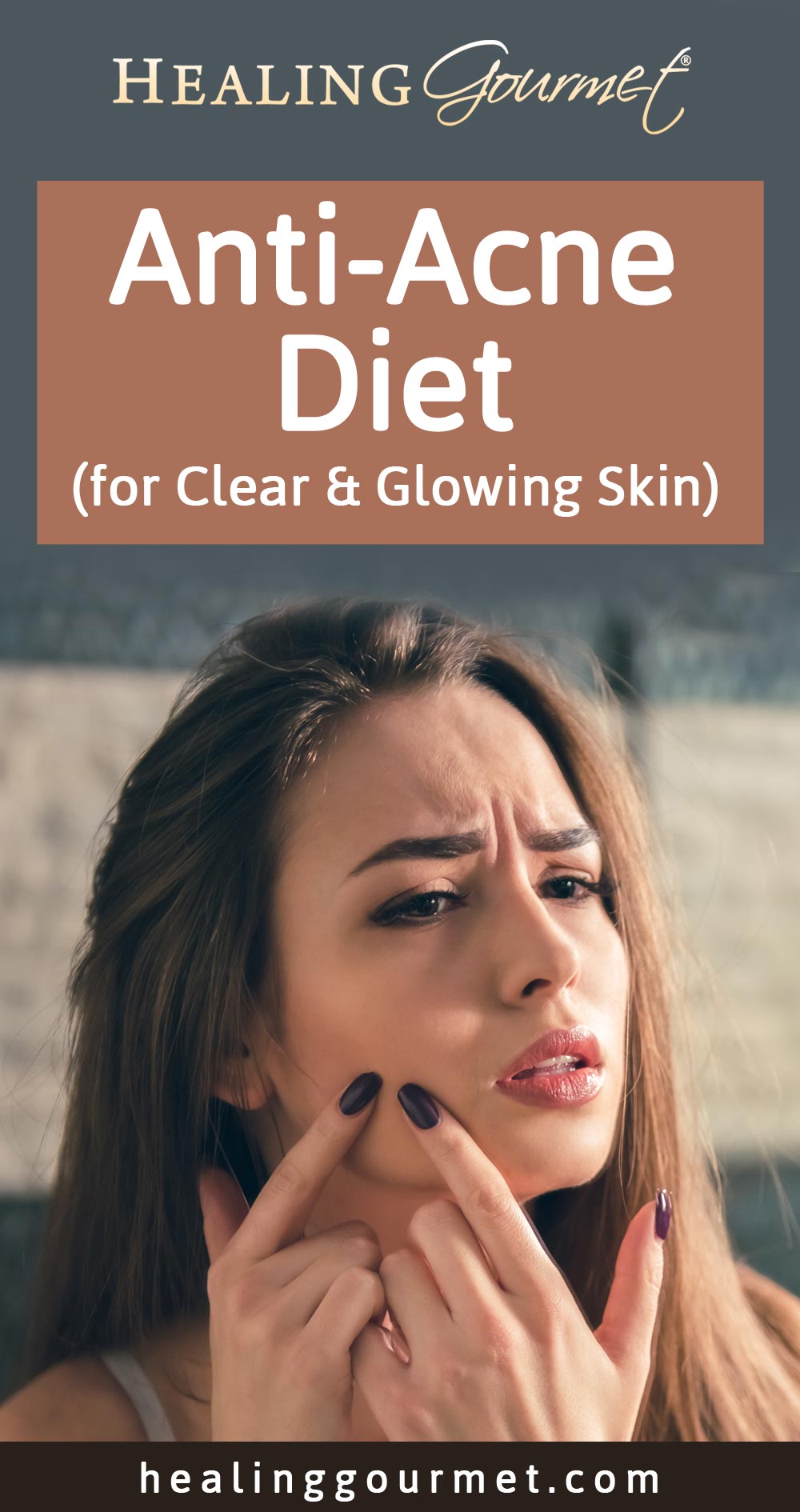Heal Acne with a Personalized Diet
If you suffer from acne, you may think it is just an uncomfortable and embarrassing condition on the surface of your skin.
But the truth is, acne is a symptom of deeper and more serious underlying health issues.
Today, you’ll discover the hormone imbalances that cause acne, the foods to avoid if you suffer from this condition, and the optimal diet to create healthy, clear and glowing skin… from within.
But first…
What is Acne?
Acne vulgaris affects up to 50 million Americans each year.
And while we consider acne to be a condition of adolescence – with 85% of people between 12 and 24 experiencing this condition – more and more people are now affected well into adulthood.[i][ii][iii][iv]
Before we get into why acne forms, let’s take a look at how acne forms:
Oil-producing glands in your skin, known as sebaceous glands, secrete a substance called sebum. Sebum is comprised of cholesterol, fatty acids, a unique compound called squalene that keeps skin moist. And while sebaceous glands are found all over your skin, your forehead and chin have the most.
Your pores (those tiny holes in your skin) connect to your sebaceous glands through canals called follicles. Sebum flows from the sebaceous glands through the follicles and out from your pores to lubricate and protect the skin.
When your biochemistry is working well, this process keeps your skin hydrated and healthy. But when there is dysfunction, excess sebum can form a plug. As bacteria becomes trapped, swelling and redness occurs and a pimple forms.
But what causes this skin-protective process to go awry?
How Does Acne Develop?
Research shows that people who develop acne have higher levels of androgens. These male-dominant hormones boost sebum production and cause oily skin.
And while androgens are responsible for male traits, we all produce these steroid hormones, with testosterone being the most well-known.[v] In males, androgens cause changes in body composition and hair growth. In females, androgens typically convert to estrogen to increase female-like characteristics.[vi]
However, whether you are male or female – high levels of circulating androgens are linked to increased breakouts. And while pubescence is the stage of life stage most notably associated with hormonal acne, it can happen any time there is a hormonal imbalance.
In fact, one of the most common causes of adult acne in women is PCOS (polycystic ovarian syndrome). Because this condition is associated with blood sugar imbalances and insulin resistance, it is often called “ovarian diabetes”. But it’s also associated with excess androgens, which upset the delicate hormonal balance and can lead to a variety of issues, including infertility… and acne.
Another hormone-like compound that influences the formation of acne is IGF-1 (insulin-like growth factor 1). IGF-1 performs a variety of unique roles in your body. When you have high blood sugar, IGF-1 acts like insulin. And it promotes bone growth during adolescence.[vii][viii]
But IGF-1 is also known to boost sebum production and promote inflammation, contributing to acne.[ix]
Finally, the microbiome of the skin also comes into play.
In healthy people, a bacterium known as Propionibacterium acnes (P. acnes) is present in the outer layer of skin in small amounts. But in those suffering from acne, the concentration of this bacteria is dramatically increased, promoting the inflammation that leads to acne.[x]
We’ve long known that the microbiome responds to stress. So, it would make sense that stress is another contributing factor in the development of acne. As your “fight-or-flight” system is engaged, compounds are formed which boost inflammatory chemicals in the skin, contributing to acne.[xi][xii]
Now that you’ve discovered what acne is, how it develops and the contributing factors to this frustrating and uncomfortable condition… let’s examine how your diet impacts the health of your skin.
How Does Diet Impact Acne?
Your diet and the health of your gut are the two key factors that influence your hormones and levels of inflammation, and therefore your risk for acne.[xiii][xiv]
So, let’s consider how common foods impact your levels of inflammation, androgens, IGF-1 and the biochemistry of your microbiome.
Sugar and Carbohydrates
Research shows that there is a clear connection between acne and a diet that is high in refined carbohydrates.[xv][xvi]
And here’s why…
When you consume high-glycemic foods, it causes a rapid spike in blood sugar. The body then releases insulin to shuttle glucose from the blood into the muscles. However, when insulin and / or blood sugar are elevated, so is your production of IGF-1 and androgen homones – both of which promote the formation of acne, as we have just discussed.[xvii]
What’s more, insulin may also reduce specific proteins that bind to androgens and IGF-1. This correlates to even higher concentrations of these acne-promoting compounds in your body.[xviii]
Conversely, a diet that keeps blood-sugar levels stable improves acne.[xix]
In a recent randomized control trial (the “gold standard” of studies), researchers gave patients with mild to moderate acne either a low-glycemic diet or a control diet for 10 weeks. At the end of the study, the low-glycemic diet group experienced significant improvements in acne lesions, reduced the size of their sebaceous glands and decreased systemic inflammation.[xx]
Dairy
Dairy has long been known to increase IGF-1 levels and activate androgen.[xxi] In fact, it is these very qualities that make dairy so popular among bodybuilders!
From a biological perspective, it makes sense that dairy would contain and boost growth hormones. The very role of dairy in nature is to increase the growth of offspring. But dairy hormones can impact your own hormonal balance, potentially leading to the development of acne.[xxii]
What’s more, most dairy in the US is treated with bovine growth hormone (rBGH) – which further increases IGF-1.[xxiii]
Interestingly, researchers have found that the type of milk matters.
In a study of over four thousand teenage boys, researchers discovered that skim milk was the most acne-promoting.[xxiv] Why might this be the case? Well, skim milk has most of the fat removed. This leaves a much higher proportion of carbohydrate, in the form of milk sugar. So, one portion of skim milk not only has more sugar than the same portion of whole milk, it also has fewer fat molecules to slow digestion and blunt the insulin response.
If you choose to consume dairy, opt for whole milk dairy, from pasture-raised cows, produced without bovine growth hormone.
Chocolate
Well-meaning moms to acne-suffering teenagers have long argued that chocolate causes zits.
We’ve seen how dairy and sugar – two ingredients that are typically found in commercially-produced chocolate – can boost levels of IGF-1.
In a recent study, researchers gave either milk chocolate or jelly beans to college students. Forty-eight hours later they assessed their acne development. The chocolate-eating students experienced a statistically significant increase in acne lesions, compared to the jelly-bean group.[xxv]
Since both candies are high in sugar – and jelly beans actually have a higher glycemic value – what could it be about the cocoa that promotes acne?
Researchers discovered that chocolate can increase inflammatory molecules called interleukins in people suffering from acne.[xxvi]
If you struggle with acne, remove chocolate from your diet for 2-4 weeks to determine how it may affect your skin.
Sucralose
The artificial sweetener, sucralose, is an organochlorine. And it has long been known to promote dysbiosis, a harmful imbalance of bacteria in the gut.[xxvii]
When healthy forms of bacteria are diminished and unhealthy populations flourish, a wide range of digestive symptoms can occur. This may include bloating, diarrhea, and ulcers. But the effects of sucralose go beyond simple digestive annoyances – this harmful chemical sweetener can also impact your metabolism and hormones.
In fact, sucralose has been found to have long-term effects on weight gain. And it can worsen the effects of diabetes, due to disruption of the metabolic system.[xxviii]
Because sucralose can impact insulin and other hormones, it can show up as acne in your skin.
Avoid sucralose – not just for the role it may play in your appearance – but for the severe, long-term health consequences associated with this chemical sweetener.
Omega-6 Fats
As we’ve discussed in the previous sections, inflammation is strong driving force of acne. In fact, many experts argue that acne is an inflammatory disease.[xxix]
And when it comes to inflammation, one of the most important dietary considerations is the type of fat you consume.
While our ancestors evolved eating roughly-equivalent amounts of omega-6 and omega-3 fatty acids, many who consume the Standard American Diet have a ratio as high as 50:1 (primarily derived from vegetable and seed oils).[xxx]
This imbalance promotes the systemic inflammation associated with acne (not to mention a laundry list of more serious chronic diseases).[xxxi]
Researchers at California State Polytechnic University evaluated the effects of consuming omega-3 rich fish oil to treat acne in adults. For 12 weeks, study participants consumed three grams of fish oil daily. At the end of the study, eight out of 12 subjects reported significant improvements in inflammation and skin lesions. Interestingly, the more severe the acne, the more the fish oil improved their condition.[xxxii]
Optimize your omega-6 to omega-3 ratio by avoiding vegetable and seed oils, choosing grass-fed meats over conventional grain-fed and consuming clean-sourced, wild seafood plus fish oil.[xxxiii]
Nutritional Solutions for Clear Skin
Healthy skin begins with a healthy diet. To tackle your acne and reclaim the clear skin you deserve:
- Remove all processed foods and refined sugars to optimize insulin levels. For best results, opt for a low-carb or ketogenic diet.
- Avoid growth hormones, antibiotics and other microbiome-meddling chemicals, like sucralose
- Avoid skim milk, and try eliminating dairy altogether for a period of time
- Reconsider chocolate – even dark chocolate – as it may be a trigger for acne in some people
- Ensure a healthy nutritional balance of omega-6 to omega-3 by avoiding all vegetable and seed oils, limiting intake of nuts and seeds, and increasing wild, sustainable seafood
- Always choose grass-fed and pasture-raised meats which contain the ideal balance of omega-6 to omega-3 fats, without the growth hormones and antibiotic residues in conventionally-raised livestock
- Manage stress levels with exercise, meditation and hobbies you enjoy
- Be cautious with the products you use. Many “pharmaceutical grade” preparations and prescription antibiotics damage the skin’s microbiome and can actually worsen acne
- Don’t pick! Consider purchasing a high-frequency machine (about $30 on Amazon) to help treat inflamed lesions and improve the bacterial balance of your skin, right in the comfort of your own home.





Leave a Reply